Adirondack Mixed Forest
Spruce Flats
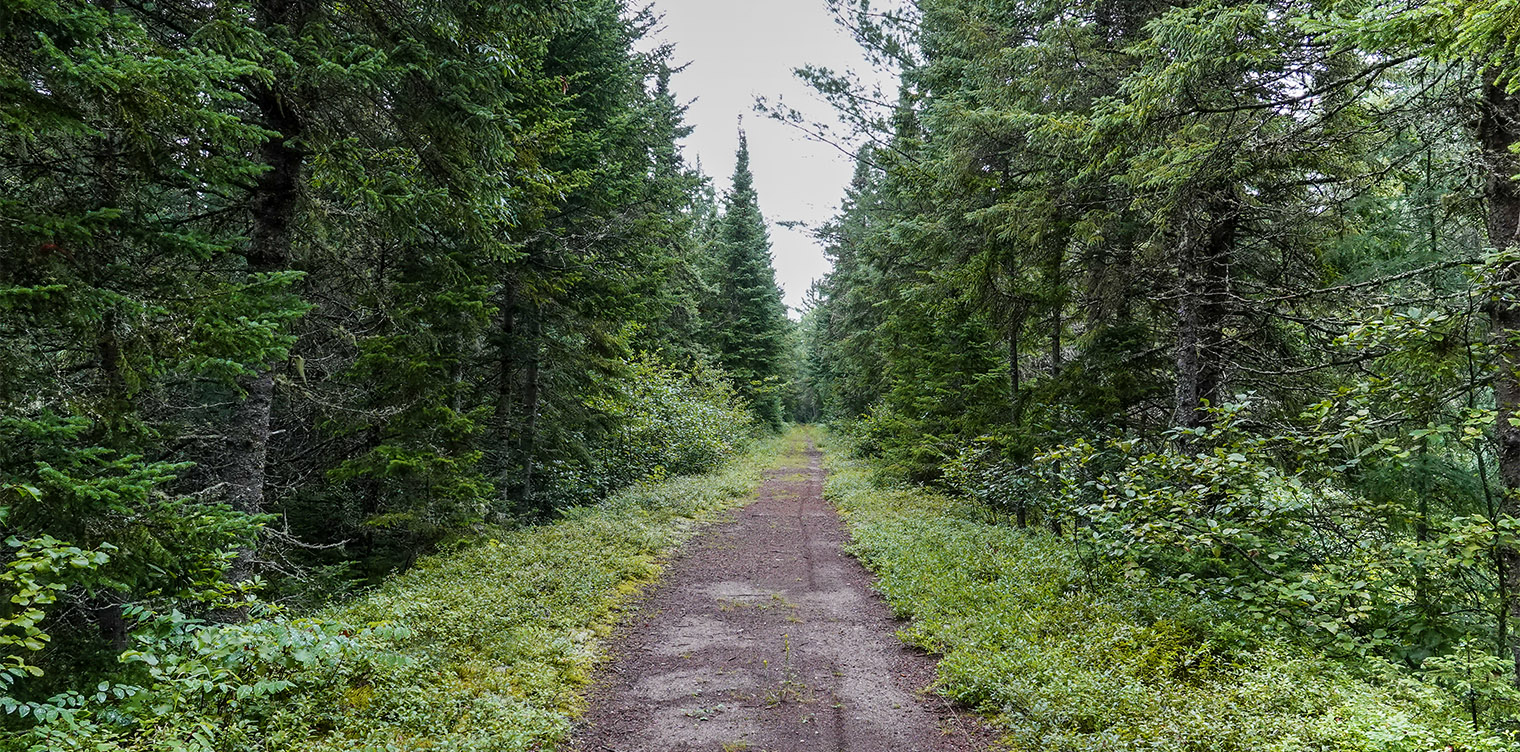
The spruce flats ecological community is one of four main mixed forest habitats found in the Adirondack Park. The others are :
The spruce flats ecological community is limited to the northern portion of New York State. It is concentrated in the Adirondack Mountains.
Spruce Flats: Overview
The spruce flats ecological community is a mixed forest often found on moist sites along the borders of swamps, as well as along lakes and streams. This community is transitional between wetland and upland. The soil is loamy to sandy; it is usually saturated in the early spring right after the snow melts, but moderately well-drained for much of the growing season.
This ecological community is found at elevations between 1,380 and 2,589 feet. In terms of global distribution, it is limited to the northeastern US and southeastern Canada. It can be found north to central Ontario and Quebec, west to Minnesota, south to northern Michigan and northern New York, and east to Nova Scotia and Newfoundland.
Within New York State, the spruce flats ecological community is concentrated within the Adirondack Park Blue Line, but can also be found along the Saint Lawrence River and Lake Champlain Lowlands, as well as on the Rensselaer Plateau (in eastern New York State, between Albany and the Massachusetts and Vermont borders) and the Tug Hill Area (immediately west of the Adirondack Park).
Plants of the Spruce Flats Ecological Community
- Shrubs
- Sheep Laurel
- Hobblebush
- Velvet-leaved Blueberry
- Ferns
- Cinnamon Fern
- Spinulose Wood Fern
- Interrupted Fern
- Mosses & Liverworts
- Schreber's Big Red Stem Moss
- Stair-step Moss
- Bazzania Trilobata
- Common Haircap Moss
- Sphagnum spp.
- Leafy Liverwort
Spruce Flats: Characteristic Trees & Shrubs
The canopy in the spruce flats ecological community is dominated by Red Spruce and Red Maple. On some sites, Red Spruce and Yellow Birch (sometimes mixed with Eastern Hemlock) make up about ¾ of the canopy cover. The shrub layer in spruce flats sites is generally sparse and patchy.
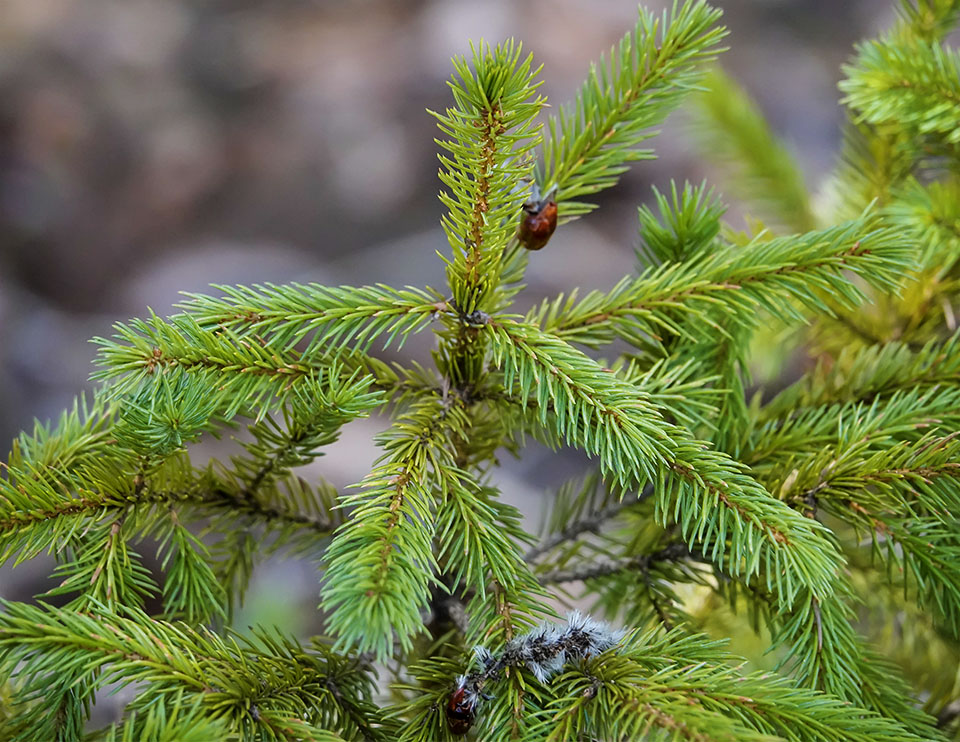
This community, as the name implies, is dominated by Red Spruce (Picea rubens) – a medium-sized evergreen conifer that grows in cool, boreal forests of the northeast, including the Adirondack Mountains. Red Spruce is the conifer species most typical of the Adirondack region as a whole. Early records suggest that Red Spruce constituted a quarter of the forest cover in the northern Adirondacks at one time.
Red Spruce is one of the most important forest trees in the northeast. It is used primarily for lumber and pulpwood. It also provides food and cover for various mammals and birds.
Red Spruce trees grow in climates with cool, moist summers and cold winters. It prefers well-drained soils, but can also grow in moister soils. It is found in both conifer and mixed woods forests, as well as in some wetland habitats. It can grow in a wide variety of ecological communities in addition to spruce flats.
Although the shrub layer tends to be sparse in most parts of the spruce flats ecological community, Sheep Laurel (Kalmia angustifolia) may be found in patchy areas. A member of the Heath family, Sheep Laurel is a low evergreen shrub which bears a cluster of deep pink flowers in late spring and early summer. The flowers appear underneath the new leaves, and the flower cluster encircles the stem. Sheep Laurel is a common under-story shrub in sub-alpine forests, wet acidic peatlands, and forest edges. Sheep Laurel is found in northeastern North America and most counties in the eastern part of New York State. This plant is found in all counties within the Adirondack Park Blue Line.
Spruce Flats: Plants of the Forest Floor
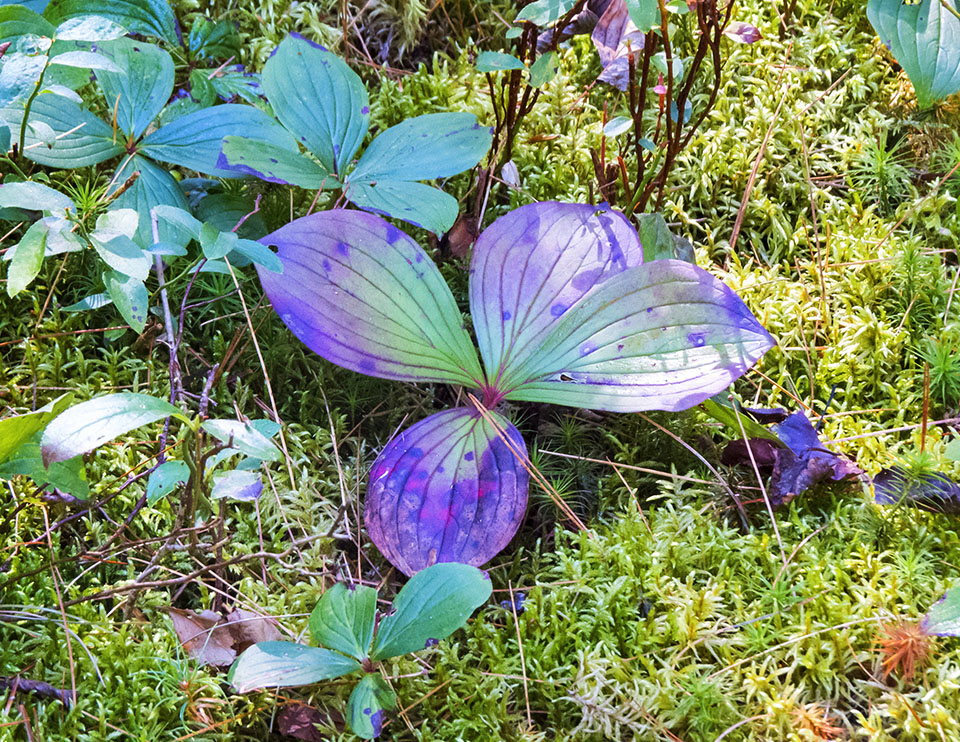
The forest floor in the spruce flats ecological community is usually covered by mosses, wildflowers, and ferns. One of the most abundant wildflowers is Bunchberry – a very common wildflower that that produces dogwood-like white flowers in spring, followed by bright red berries in summer. Its dark green, shiny leaves appear to grow in whorls of four to six.
Bunchberry provides a food source for some species of wildlife. In some parts of its range, White-tailed Deer consume Bunchberry foliage, as do caribou, moose, and elk, although this plant does not appear to be a preferred food source for any of them. Bunchberry fruits are eaten by American Black Bears and small mammals. Eastern Chipmunks, American Martens, Eastern Cottontails, and Snowshoe Hares feed on bunchberry stems and fruits. Bunchberry is also used by some song and game birds.
Bunchberry and other wildflowers that flourish in the spruce flats ecological community are often found growing on a bed of moss, including Schreber's Big Red Stem Moss (Pleurozium schreberi), a feathery, sprawling moss that occurs on the forest floor of boreal forests in the northeastern US and Canada. Ketchledge's 1980 checklist of New York State mosses lists this moss as present in all four core Adirondack Park grids. Schreber's Big Red Stem Moss is very shade tolerant and typically occurs in late stages of succession. It is found on stumps, logs, and the forest floor in conifer-dominated forests and wooded swamps. This moss often covers the forest floor in extensive mats.
Spruce Flats: Characteristic Birds
Wildlife of the Spruce Flats Ecological Community
The spruce flats ecological community hosts a variety of boreal birds, including the Canada Jay, a year-round resident of coniferous forests in the Adirondack Mountains. Canada Jays are stocky gray and white birds, slightly smaller than a Blue Jay, with fluffy plumage that it puffs up in cold weather. In contrast to most other birds that make their homes in the Adirondacks and other boreal forests, Canada Jays nest in late winter rather than spring, with nest building as early as February.
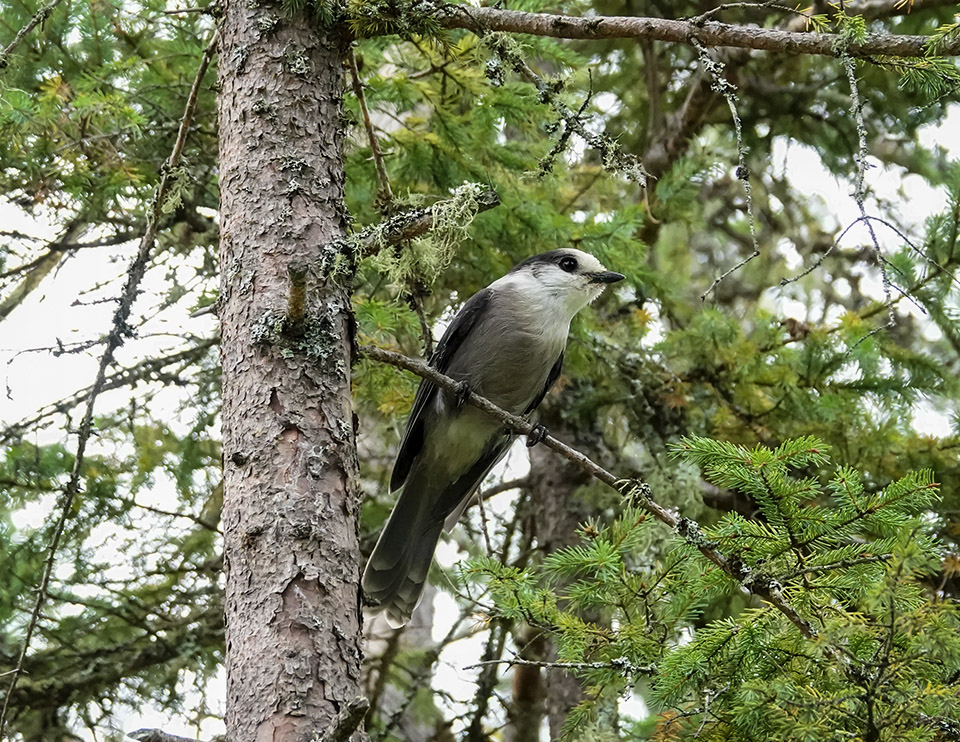
Canada Jays are found from Alaska east across Canada to Labrador. Their range extends south to the western edge of Washington and California, the mountains of Arizona, along the Rocky Mountains, New Mexico, northern Minnesota and Wisconsin, northern New York State, and northern New England. Canada Jays reside in conifer and mixed conifer-deciduous forests where spruce trees are present. In the Adirondack Park, Canada Jays prefer medium to mature boreal forest.
Blackburnian Warblers may also be seen in the spruce flats ecological community. However, in contrast to Canada Jays, Blackburnians are Neotropical migrantsNeotropical migrant/Neotropical migratory birds: Any species of bird whose breeding area includes the North American temperate zones and that migrates south of the continental United States during nonbreeding seasons. Neotropical migrant birds breed in North America during the spring and early summer and spend the winter in Mexico, the Caribbean, and Central and South America. , meaning birds that winter to the south of the continental United States and migrate to North American temperate zones to breed in the spring and summer. The winter range of Blackburnian Warblers is mainly in southern Central America and northern South America. Blackburnian Warblers migrate to the Adirondack Mountains and other breeding grounds in the spring. They arrive in the Adirondack Park starting in very late April and begin leaving our region in late summer and early fall.
The Blackburnian Warbler is characteristically associated with mature conifer forests (such as balsam flats and mountain spruce-fir forests) and mixed forests dominated by conifers, such as hemlock-northern hardwood forests and spruce flats. Blackburnian Warblers show a marked preference for old-growth stands that contain only conifers or mixed stands that include tall conifers such as Eastern Hemlock, White Spruce, Red Spruce, Eastern White Pine, and Balsam Fir, as well as deciduous trees such as American Beech, Sugar Maple, and Yellow Birch. Blackburnians reportedly avoid even-aged stands that lack emergent trees.
Spruce Flats: Characteristic Mammals
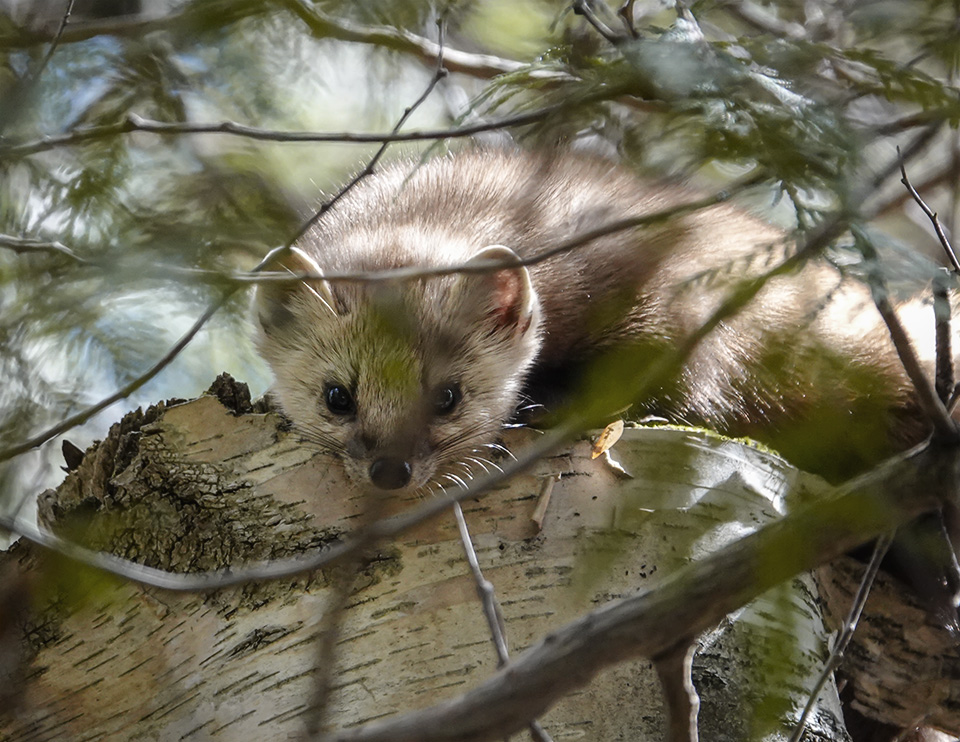
Characteristic mammals found in spruce flats ecological communities include the American Marten. Like the Fisher, American Martens occupy conifer-dominated forests, avoiding areas that lack overhead cover. American Martens are omnivores that consume fruits and seeds in summer and fall. However, the bulk of their diet consists of small animals including Red Squirrels, Snowshoe Hares, moles, shrews, and Southern Red-backed Voles.
Red Squirrels are also found in spruce flats ecological communities. The Red Squirrel is one of six members of the squirrel family (Sciuridae) who make their home in the Adirondacks. Red Squirrels are small reddish brown rodents with large dark eyes, made more prominent by thick bright white eye-rings. The Red Squirrel's long, bushy tail, often carried over or against the back, accounts for nearly a third of its total length.
The Red Squirrel is an omnivore, meaning that it consumes both plant and nonplant material. Plant material is the squirrel's mainstay. In the Adirondacks, the main items on the Red Squirrel's menu are seeds from conifer cones, including Red Spruce. Red Squirrels harvest the cones when they are green, climbing along the branches to snip off the cones and then descending to retrieve them. The squirrels extract the seeds from the cones, leaving behind piles of cone fragments called middens. Red Squirrels also consume insects, worms, and vertebrates, including small mammals (such as newborn Snowshoe Hares) and birds.
Spruce Flats: Outlook
The current trend for the spruce flats ecological community in the Adirondack region is considered to be stable for public lands and private conservation land. Outside of these areas, the number and acreage of this community have probably been declining slightly due to logging and development.
Longterm threats to spruce flats ecological communities in the Adirondacks include forest fragmentation, development, invasive species, and over-browsing by deer. Other threats include excessive logging and recreational overuse, such as increased activities by all-terrain vehicles and snowmobiles.
The dominant tree species in the spruce flats ecological community – Red Spruce – is also vulnerable to damage from acid rain. Although acid rain – the result of pollutants in the emissions from power plants and other industrial facilities – has stressed Adirondack forests as a whole, Red Spruce has experienced particularly heavy losses.
References
New York State. Department of Environmental Conservation. New York Natural Heritage Program. Ecological Communities of New York State. Second Edition (March 2014), pp. 118, 121-123, 125. Retrieved 26 January 2025.
New York Natural Heritage Program. 2025. Online Conservation Guide for Spruce Flats. Retrieved 26 January 2025.
NatureServe. 2025. NatureServe Explorer. Acadian Sub-boreal Spruce Flat. Retrieved 26 January 2025.
The Nature Conservancy. Northeast Habitat Map. Retrieved 26 January 2025.
The Nature Conservancy. Acadian Sub-boreal Spruce Flat. Retrieved 26 January 2025.
Cornell Lab of Ornithology, Ithaca, New York. All About Birds. Black-backed Woodpecker, Blackburnian Warbler, Boreal Chickadee, Canada Jay, Golden-crowned Kinglet. Ruby-crowned Kinglet, Swainson's Thrush, White-throated Sparrow, Yellow-bellied Flycatcher. Retrieved 26 January 2025.
Cornell Lab of Ornithology, Ithaca, New York. Birds of North America. Subscription Web Site. Black-backed Woodpecker, Blackburnian Warbler, Boreal Chickadee, Canada Jay, Golden-crowned Kinglet, Ruby-crowned Kinglet, Swainson's Thrush, White-throated Sparrow, Yellow-bellied Flycatcher. Retrieved 26 January 2025.
E. Lucy Braun. Deciduous Forests of Eastern North America (Hafner Publishing Company, 1964), pp. 412-422. Retrieved 26 January 2025.
Roger A. Powell, Seven W. Buskirk, and William J. Zielinski, "Fisher and Marten," in George A. Feldhamer, Bruce C. Thompson, and Joseph A. Chapman (Eds). Wild Mammals of North America: Biology, Management, and Conservation. Second Edition (The Johns Hopkins University Press, 2003) pp. 635-649. Retrieved 26 January 2025.
State University of New York. College of Environmental Science and Forestry. American Marten. Martes americana Turton. Retrieved 26 January 2025.
USDA. Plants Database. Schreber's Big Red Stem Moss. Pleurozium schreberi (Brid.) Mitt. Retrieved 26 January 2025.
Karl B McKnight et al. Common Mosses of the Northeast and Appalachians (Princeton University Press, 2013), pp. 286-287.
Edwin H. Ketchledge. Revised Checklist of the Mosses of New York State (University of the State of New York, 1980), p. 13. Retrieved 26 January 2025.
Northern Forest Atlas. Pleurozium schreberi. Retrieved 26 January 2025.
University of British Columbia. Introduction to Bryophytes. Pleurozium schreberi. Retrieved 26 January 2025.
USDA Forest Service Fire Effects Information System. Pleurozium schreberi. Retrieved 26 January 2025.
Ohio Moss & Lichen Association. Pleurozium schreberi. Phoenix Feather Moss. Retrieved 26 January 2025.
E. H. Ketchledge. Forests and Trees of the Adirondack High Peaks Region (Adirondack Mountain Club, 1967).
John Kricher. A Field Guide to Eastern Forests. North America (Boston: Houghton Mifflin, 1998). Retrieved 26 January 2025.
Peter J. Marchand. Nature Guide to the Northern Forest. Exploring the Ecology of the Forests of New York, New Hampshire, Vermont, and Maine (Appalachian Mountain Club, 2010).
